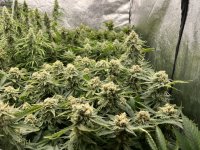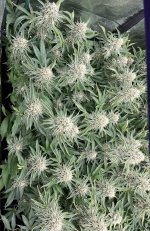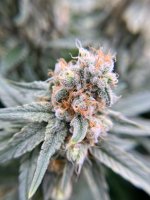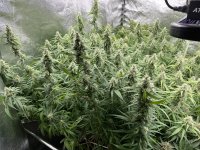XenoCannaLabs
Active member
The idea with this post is to show what I've learnt in respect to 'pre loading' and maybe help a few people out with ideas and practices i have great success with. Also with the aim to keep costs to a minimum and make it as easy as possible to produce some nice flowers/resin.
I'm a by no means the inventor of this idea, and all I've learnt has come from books like the Teaming series from Jeff Lowenfels, and people like Charles Dowding and Dragon fly earth medicine, amongst others.
The term pre loading refers to the idea of mixing the right amount of dry amendments into the substrate, to last it the whole flower cycle. The aim is just to use de chlorinated water and a microbe tea mix once/twice a week. I'm trying not to use or rely upon any bottled salt nutrients. This in turn should keep costs down for feeding and also produce a very much organic end product. Along with a few other techniques I've learnt, the cost of growing cannabis is reduced further.
First thing. My pot size is important to consider. In my research, I found some good info and gained some experience regarding pot size. As this directly correlates to plant size in my organic system, and since im indoors this is an important thing to consider. I've used 30,15, 10, 9, and 7 litre pots trying to find the best fit for me. For my situation. 1x1 tents, I like to have Sats/indicas doms, and evenly mixed hybrids and multiple flavours, so there is a lot of varying flower times and frequent crops. Too larger pot hinders this. For me I'm using 7 litres as my flowering pots. This isn't large by any means but works well for me and my space and produces a good sized plant. Of you who have a larger space, I'm jealous, and the principle of pre loading still applies.
Second. Your base substrate needs to be of a high quality. I've mixed my own in the past and had just as much success. U can pick up good quality compost from most garden centres. If u can , make sure u get it from a place that keeps their stock in the dry. Ive personally used Melcourt Organic peat free mixed with as pure peat based compost as u can get. Westland seed and cutting is pure peat basically. Mix the two and you will have a beautiful substrate to grow in.
The only problem I really had was fungus gnats. But a good dose of Nematodes, in combination with sticky traps can keep populations almost to zero. This method is very cost effective, but requires abit of work.
For this post, though, I'll be using Biobizz All mix. It is expensive but I've had very good results with this substrate. I even pot fresh rooted cuts straight into this, with no ill effect. It's pH is 6.2 with an ec of 2.2 so quite a strong mix relatively speaking. The mix consists of, Peat moss, sphagnum peat, perlite and pre mix which is different organic fertilizers, rock meals, trace elements, and fungi. Like I said I've had great results with this product, I'm sure there are other good ones out there too that u can try. Or make up your own mix. For me This is very convenient and of a great quality that I cant fault it. So we have the All mix, according to the bag it has enough feed for up to 4weeks. And that's a very rough number. That fully depends on your environment and genetics. I take that into consideration when adding the dry ammendments. So I go from 2 litre straight to 7 litre in my case. At this point the plant has probably been veging for around 4/5 weeks. Pots full of roots, shes raring to go. I would mix enough dry ammendments into the All mix, to last it till I chop. This process relies on that from the moment the cut has rooted, placing it in a fungal and highly microbial environment, so the plant gets used to that environment and forms the necessary relationships. All mix fits the bill perfectly. High npk salt nutrients stop these relationships from forming though. Its extremely important that the plant forms those relationships ASAP as it is the key to organic growing in a small pot, or any pot for that matter.
Third. The dry ammendments. There is alot out there. I've tried afew. I'll get straight to the point. Charge and palm tree ash. Charge is a biostimulant from Ecothrive it consists of mealworm castings with an npk of 3 2 3. With trace elements Calcium magnesium sulphur and copper. Also beneficial rhizosphere colony forming bacteria and enzymes. The ash is considered an organic and vegan fert with an pk of 1 30. So very potent, u only need a small amount to go along way. It's from guanokalong and they do a whole range that is pretty good. I mixed the desired amount into the required amount of soil and pot up as usual. I then water in. I have plants I crop at 8 weeks and others at 15 weeks. I tweak the amounts slightly depending on crop time but surprisingly not much. The key with longer flowers is using microbe tea and maybe some anaerobic digestate.
Forth. Watering and microbe tea. Maybe the most important. As with all life water is key. Cannabis in ideal conditions grows fast and will drink well. The microbial life, fungi and other soil life needs water to work, so first u need to dechlorinate your water (this is VERY important) as chlorine is NOT conducive to a happy rhizosphere and soil health. I use neutralise from ecothrive. It's often recommended that u let the substrate dry out between each watering. Ive found that u don't want to let it dry completely, especially in an organic systems as this seriously reduces the bio activity. So finding the sweet spot is key.
Ideally your first watering after potting up will be with a Microbe tea, as this really helps get things going. I use Biosys again from ecothrive( them guys have got you covered) It has all that good stuff Endo Myco, Tricho, Bacillus ect. Nitrogen fixing bacteria. The interesting stuff for me is the microbial catalysts and plant growth promoting stimulants. Humic acid, amino acids, enzymes, yeasts, proteins, carbs and seaweed extract. This helps feed the soil life and in turn feeds the plant. Being an annual, cannabis thrives in microbe rich soils so all these things help feed and form microbes and soil life, and help facilitate food production for the plant.
Fifth. Other tips and tricks.
Coco pot toppers. I've been by using these for a while now. By using them the plants roots come right to the surface, utilising all the soil has to offer. Not using the toppers I've found upto a third of the soil can have very little to no roots, especially under intense LED lights. The cover keeps the root zone cool also protecting the rhizosphere and also reduces evaporation. Minimise watering and better use of the water u give it. I make mine from cutting appropriate size pieces from coco liner for hanging baskets.
Anaerobic digestate. (Search it) This stuff is incredible. I use it for every thing in my outside garden too. It's got abit of a stink though. U can get it from alot of garden centres and it's not expensive at all. I use Plant grow. It's full of bacteria and fungi. Great little accompaniment to an organic regime.
Amino acids and Enzymes. I use RAW soluble. Its pricey but as i only use a very very small ammount, the smallest pack last me nearly a year. Adding alittle extra of these ingredients Is useful , but not an absolute must. I've had success with out them. But when I use them it allows the soil to work extra hard, potentially increasing yeild but more importantly effect and flavour.
Reading material. If u are interested in an indepth look at how the soil food web works. Read Jeff Lowenfels 3 part book series. I can't recommend it enough .
Bottled nutes. Like I mentioned above I have used them in the past for both DWC and coco systems. My preferred choice was Genesis. I still might use the micro base now and again in very small amount as its a good produce. The other bottle nutrient I might use now and again in very small quantities is the classic calcium magnesium combo. The emphasis is on very SMALL amounts.
Conclusion
I'm fully aware that trying to mimic growing outside in the earth in a small pot is an almost impossible task. Even with very large indoor beds to create a no till closed loop system, its certainly not easy to create such an environment. This idea of pre loading the soil with organic ammendments, and having a high microbe and fungi population to help break things down and make them accessible to the plant, in my mind engages with a much more ancient and natural processes. This in turn, produces a more natural tasty flowers/resin, and allows in to maximise the compounds present in the end product. This can be done in small pots. I certainly have had great success using this method. I definitely would recommend trying it. Don't get me wrong, I've used salt nutrients in the past and produced some nice flower. I understand the uses and where they can come in very handy. But the flower/resin i grow using an organic regime is of a better quality imo.
I hope I've explained my process clearly and logically. And ive probably explained lots of stuff everyone on here knows but its nice to be able to get this info down and share it. To whoever reads the whole thing, thank you, and if anyone has any questions about what i do. I'll try my best to answer them.. Peace.

Amhz


Blue Jam

Sk1

Dr Grinspoon
(Talk is cheap, right?
All grown in the above mentioned way)
I'm a by no means the inventor of this idea, and all I've learnt has come from books like the Teaming series from Jeff Lowenfels, and people like Charles Dowding and Dragon fly earth medicine, amongst others.
The term pre loading refers to the idea of mixing the right amount of dry amendments into the substrate, to last it the whole flower cycle. The aim is just to use de chlorinated water and a microbe tea mix once/twice a week. I'm trying not to use or rely upon any bottled salt nutrients. This in turn should keep costs down for feeding and also produce a very much organic end product. Along with a few other techniques I've learnt, the cost of growing cannabis is reduced further.
First thing. My pot size is important to consider. In my research, I found some good info and gained some experience regarding pot size. As this directly correlates to plant size in my organic system, and since im indoors this is an important thing to consider. I've used 30,15, 10, 9, and 7 litre pots trying to find the best fit for me. For my situation. 1x1 tents, I like to have Sats/indicas doms, and evenly mixed hybrids and multiple flavours, so there is a lot of varying flower times and frequent crops. Too larger pot hinders this. For me I'm using 7 litres as my flowering pots. This isn't large by any means but works well for me and my space and produces a good sized plant. Of you who have a larger space, I'm jealous, and the principle of pre loading still applies.
Second. Your base substrate needs to be of a high quality. I've mixed my own in the past and had just as much success. U can pick up good quality compost from most garden centres. If u can , make sure u get it from a place that keeps their stock in the dry. Ive personally used Melcourt Organic peat free mixed with as pure peat based compost as u can get. Westland seed and cutting is pure peat basically. Mix the two and you will have a beautiful substrate to grow in.
The only problem I really had was fungus gnats. But a good dose of Nematodes, in combination with sticky traps can keep populations almost to zero. This method is very cost effective, but requires abit of work.
For this post, though, I'll be using Biobizz All mix. It is expensive but I've had very good results with this substrate. I even pot fresh rooted cuts straight into this, with no ill effect. It's pH is 6.2 with an ec of 2.2 so quite a strong mix relatively speaking. The mix consists of, Peat moss, sphagnum peat, perlite and pre mix which is different organic fertilizers, rock meals, trace elements, and fungi. Like I said I've had great results with this product, I'm sure there are other good ones out there too that u can try. Or make up your own mix. For me This is very convenient and of a great quality that I cant fault it. So we have the All mix, according to the bag it has enough feed for up to 4weeks. And that's a very rough number. That fully depends on your environment and genetics. I take that into consideration when adding the dry ammendments. So I go from 2 litre straight to 7 litre in my case. At this point the plant has probably been veging for around 4/5 weeks. Pots full of roots, shes raring to go. I would mix enough dry ammendments into the All mix, to last it till I chop. This process relies on that from the moment the cut has rooted, placing it in a fungal and highly microbial environment, so the plant gets used to that environment and forms the necessary relationships. All mix fits the bill perfectly. High npk salt nutrients stop these relationships from forming though. Its extremely important that the plant forms those relationships ASAP as it is the key to organic growing in a small pot, or any pot for that matter.
Third. The dry ammendments. There is alot out there. I've tried afew. I'll get straight to the point. Charge and palm tree ash. Charge is a biostimulant from Ecothrive it consists of mealworm castings with an npk of 3 2 3. With trace elements Calcium magnesium sulphur and copper. Also beneficial rhizosphere colony forming bacteria and enzymes. The ash is considered an organic and vegan fert with an pk of 1 30. So very potent, u only need a small amount to go along way. It's from guanokalong and they do a whole range that is pretty good. I mixed the desired amount into the required amount of soil and pot up as usual. I then water in. I have plants I crop at 8 weeks and others at 15 weeks. I tweak the amounts slightly depending on crop time but surprisingly not much. The key with longer flowers is using microbe tea and maybe some anaerobic digestate.
Forth. Watering and microbe tea. Maybe the most important. As with all life water is key. Cannabis in ideal conditions grows fast and will drink well. The microbial life, fungi and other soil life needs water to work, so first u need to dechlorinate your water (this is VERY important) as chlorine is NOT conducive to a happy rhizosphere and soil health. I use neutralise from ecothrive. It's often recommended that u let the substrate dry out between each watering. Ive found that u don't want to let it dry completely, especially in an organic systems as this seriously reduces the bio activity. So finding the sweet spot is key.
Ideally your first watering after potting up will be with a Microbe tea, as this really helps get things going. I use Biosys again from ecothrive( them guys have got you covered) It has all that good stuff Endo Myco, Tricho, Bacillus ect. Nitrogen fixing bacteria. The interesting stuff for me is the microbial catalysts and plant growth promoting stimulants. Humic acid, amino acids, enzymes, yeasts, proteins, carbs and seaweed extract. This helps feed the soil life and in turn feeds the plant. Being an annual, cannabis thrives in microbe rich soils so all these things help feed and form microbes and soil life, and help facilitate food production for the plant.
Fifth. Other tips and tricks.
Coco pot toppers. I've been by using these for a while now. By using them the plants roots come right to the surface, utilising all the soil has to offer. Not using the toppers I've found upto a third of the soil can have very little to no roots, especially under intense LED lights. The cover keeps the root zone cool also protecting the rhizosphere and also reduces evaporation. Minimise watering and better use of the water u give it. I make mine from cutting appropriate size pieces from coco liner for hanging baskets.
Anaerobic digestate. (Search it) This stuff is incredible. I use it for every thing in my outside garden too. It's got abit of a stink though. U can get it from alot of garden centres and it's not expensive at all. I use Plant grow. It's full of bacteria and fungi. Great little accompaniment to an organic regime.
Amino acids and Enzymes. I use RAW soluble. Its pricey but as i only use a very very small ammount, the smallest pack last me nearly a year. Adding alittle extra of these ingredients Is useful , but not an absolute must. I've had success with out them. But when I use them it allows the soil to work extra hard, potentially increasing yeild but more importantly effect and flavour.
Reading material. If u are interested in an indepth look at how the soil food web works. Read Jeff Lowenfels 3 part book series. I can't recommend it enough .
Bottled nutes. Like I mentioned above I have used them in the past for both DWC and coco systems. My preferred choice was Genesis. I still might use the micro base now and again in very small amount as its a good produce. The other bottle nutrient I might use now and again in very small quantities is the classic calcium magnesium combo. The emphasis is on very SMALL amounts.
Conclusion
I'm fully aware that trying to mimic growing outside in the earth in a small pot is an almost impossible task. Even with very large indoor beds to create a no till closed loop system, its certainly not easy to create such an environment. This idea of pre loading the soil with organic ammendments, and having a high microbe and fungi population to help break things down and make them accessible to the plant, in my mind engages with a much more ancient and natural processes. This in turn, produces a more natural tasty flowers/resin, and allows in to maximise the compounds present in the end product. This can be done in small pots. I certainly have had great success using this method. I definitely would recommend trying it. Don't get me wrong, I've used salt nutrients in the past and produced some nice flower. I understand the uses and where they can come in very handy. But the flower/resin i grow using an organic regime is of a better quality imo.
I hope I've explained my process clearly and logically. And ive probably explained lots of stuff everyone on here knows but its nice to be able to get this info down and share it. To whoever reads the whole thing, thank you, and if anyone has any questions about what i do. I'll try my best to answer them.. Peace.
Amhz
Blue Jam
Sk1
Dr Grinspoon
(Talk is cheap, right?
All grown in the above mentioned way)
Last edited:






